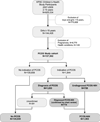Prevalence of polycystic ovary syndrome in adolescents
- PMID: 23756098
- PMCID: PMC3813299
- DOI: 10.1016/j.fertnstert.2013.04.001
Prevalence of polycystic ovary syndrome in adolescents
Abstract
Objective: To investigate the prevalence of polycystic ovary syndrome (PCOS) in adolescents and its association with obesity.
Design: Cross-sectional study using electronic medical records.
Setting: Not applicable.
Patient(s): Adolescents aged 15-19 years (n = 137,502).
Intervention(s): None.
Main outcome measure(s): PCOS diagnosed or defined according to National Institutes of Health (NIH) criteria.
Result(s): The prevalence of a confirmed diagnosis of PCOS was 0.56%, which increased to 1.14% when undiagnosed cases with documented symptoms qualifying for PCOS according to NIH criteria were included. Compared with normal/underweight girls, the odds ratios (OR and 95% confidence interval [CI]) for confirmed PCOS diagnosis were 3.85 (3.04-4.88), 10.25 (8.16-12.84), and 23.10 (18.66-28.61) for overweight, moderately obese, and extremely obese adolescents, respectively, after adjusting for potential confounders. When adolescents with two or more supportive diagnoses were included (diagnosed and undiagnosed PCOS-NIH), the ORs (95% CI) for PCOS-NIH by weight class were significantly attenuated to 2.95 (2.53-3.44), 6.73 (5.78-7.83), and 14.65 (12.73-16.86) for overweight, moderately obese, and extremely obese adolescents, respectively.
Conclusion(s): Overweight and obesity were associated with higher odds of PCOS in adolescents. Studies based solely on diagnosis codes may underestimate the prevalence of PCOS and overestimate the magnitude of the association between obesity and PCOS.
Keywords: Adolescence; body weight; childhood; epidemiology; obesity; polycystic ovary syndrome.
Copyright © 2013 American Society for Reproductive Medicine. Published by Elsevier Inc. All rights reserved.
Conflict of interest statement
There are no financial conflicts of interest to disclose.
Figures
References
-
- American College of Obstetricians and Gynecologists. ACOG Practice Bulletin No. 108: Polycystic ovary syndrome. Obstet Gynecol. 2009;114:936–949. - PubMed
-
- Zawadski JK, Dunaif A. Diagnostic criteria for polycystic ovary syndrome towards a rational approach. In: Dunaif A, Givens JR, Haseltine F, editors. Polycystic Ovary Syndrome. Boston: Blackwell Scientific; 1992. pp. 377–384.
-
- Franks S. Polycystic ovary syndrome in adolescents. Int J Obes. 2008;32:1035–1041. - PubMed
-
- Ehrmann DA, Kasza K, Azziz R, Legro RS, Ghazzi MN Group PCTS. Effects of race and family history of type 2 diabetes on metabolic status of women with polycystic ovary syndrome. J Clin Endocrinol Metab. 2005;90:66–71. - PubMed
-
- Diamanti-Kandarakis E. PCOS in adolescents. Best Pract Res Clin Obstet Gynaecol. 2010;24:173–183. - PubMed
Publication types
MeSH terms
Substances
Grants and funding
LinkOut - more resources
Full Text Sources
Other Literature Sources
Medical



